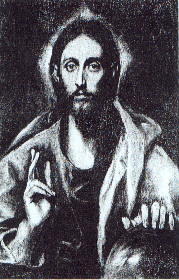|
No.
2, April 2005
SAVIOUR OF THE WORLD BY EL GRECO
Sister W. Beckett

Figure 1. Cristo Salvator Mundi c.1600 (oil on canvas) Greco, El (Domenico Theotocopuli)
(1541-1614)
National Gallery of Scotland,
Edinburgh, Suplied by the Bridgeman Art Library
We can never know what Our
Lord looked like. The writers of the gospels were wholly concerned with
what He was, what He meant, not at all with how He appeared. Does it
matter? Artists, of course, had to ‘portray’ Jesus, and nearly all do it in
much the same manner: he is beautiful, majestic, a man of dignity and,
often, compassion. El Greco, it seems to me, is alone in venturing into
that area where, although Jesus ‘appears’, it is what does not appear that
is so moving. His Jesus does not come before us with a glowing halo, He is
not about the works of His earthly apostolate, (the gospel Jesus). No, this
is Jesus Saviour of the world, glimmering on the
canvas as if for a sacred moment. He emerges from a murky obscurity; the
light that is His very self (‘I am the Light of the world’) hardly
contained His body: it softly irradiated His head. He holds with one gentle
hand the discoloured globe of our sad earth, not
holding it up – that is His Father’s work – but holding it in place,
gentling it, soothing down its roiling passions. With Jesus’ hand laid upon
it, our world is safe. Whatever tempests sweep it, peace is, in the end,
assured. This is what it means to be saved: nothing can truly hurt us. This
does not mean we shall not suffer, as He Himself did. The pale face of this
Saviour is unmistakably that of one who has
suffered. He has laid down His life for the ransom of many – (the Aramaic
phrase for all). It is not enough, thought, just to see that Jesus holds
the world still beneath His hand. With His other hand he both blesses and
beckons. We are not saved passively. It may be all God’s work, but haw can
He become effective in us unless we let Him? So Jesus calls us close, calls
us to enter into the radiance of His presence, with all that means of
desire and attention. He is always there, loving the world, offering
Himself. Prayer means that we too are there, letting Him save us, accepting
that transforming blessing. While He lived on earth, that transformation
was possible for those who actually saw Him, met Him, heard Him. But for
our sakes He died on the cross and – mysterious reality - rose. It is that
trans-temporal Jesus, that risen Lord, that El Greco holds before us, the
Jesus Saviour that is spiritually present to us
always. This is the inward Jesus, the Jesus whom we never see but who gives
our lives their meaning. This is not His face so much as His spirit. This
is the Jesus of our prayer, whose very presence takes us to the Father. The
Jesus in whom we live.
|


![]()
![]()


![]()
![]()